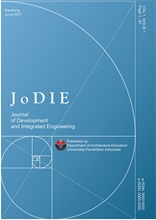ANALYSIS OF ELEMENTARY SCHOOL EDUCATION INFRASTRUCTURE FULFILLMENT IN CIBEUNYING KIDUL DISTRICT: A CASE STUDY OF PUBLIC ELEMENTARY SCHOOL 004 CICADAS AWIGOMBONG, BANDUNG CITY
Abstract
References
Afriyanie, D., Julian, M. M., Riqqi, A., Akbar, R., Suroso, D. S., and Kustiwan, I. (2020). Re-framing urban green spaces planning for flood protection through socio-ecological resilience in Bandung City, Indonesia. Cities, 101, 102710.
Amanullah, M. A. (2020). Development of digital flipbook learning media to support the learning process in the era of the industrial revolution 4.0. Journal of Education and Learning Dimensions, 8(1), 37-44.
Amoozad Mahdiraji, H., Arzaghi, S., Stauskis, G., and Zavadskas, E. K. (2018). A hybrid fuzzy BWM-COPRAS method for analyzing key factors of sustainable architecture. Sustainability, 10(5), 1626.
Hasriadi, H. (2022). Metode pembelajaran inovatif di era digitalisasi. Jurnal Sinestesia, 12(1), 136-151.
Hasriadi, H. (2022). Innovative learning methods in the digital age. Synesthesia Journal, 12(1), 136–151.
Kadaei, S., Shayesteh Sadeghian, S. M., Majidi, M., Asaee, Q., and Mehr, H. H. (2021). Hotel construction management considering sustainability architecture and environmental issues. Shock and Vibration, 2021, 1-13.
Lami, I. M., and Mecca, B. (2020). Assessing social sustainability for achieving sustainable architecture. Sustainability, 13(1), 142.
Lovelace, R., Tennekes, M., and Carlino, D. (2022). ClockBoard: A zoning system for urban analysis. Journal of Spatial Information Science, 24(24), 63-85.
Nurabadi, A., Bafadal, I., Priyatni, E. T., and Gunawan, I. (2020). Analysis of the availability of school facilities and infrastructure as an effort to accelerate school quality improvement. In 6th International Conference on Education and Technology (ICET 2020), 89-92. Atlantis Press.
Nur'aini, R. D. (2020). Application of the yin case study method in architectural and behavioral research. INERSIA: Information and Exposure of Research Results in Civil Engineering and Architecture, 16(1), 92-104.
Qutni, D., Kristiawan, M., and Fitriani, Y. (2021). Human resource management in improving the quality of education. Edunesia: Jurnal Ilmiah Pendidikan, 2(2), 354-366.
Ratri, S. Y. (2018). Digital Storytelling pada pembelajaran IPS di Sekolah dasar. Jurnal Pena Karakter, 1(1), 1-8.
Ratri, S. Y. (2018). Digital storytelling on IPS learning in elementary schools. Character Pen Journal, 1(1), 1–8.
Riyanti, E. D., Ayatina, H., Astuti, F. T., and Rahmah, P. J. (2020, August). Zoning system of education in indonesia challenges and their future. In 1st Progress in Social Science, Humanities and Education Research Symposium (PSSHERS 2019), 1111-1114.
Sunandar, A., Ediyanto, E., Firdiana, A. D., Hadiana, D., Nafiah, M. Z. I., Lailiyah, N. M., ... and Hadayani, S. (2022). Equality analysis of the right education for disabilities: a juridical and factual study implementation of management inclusion education. Journal of ICSAR, 6(2), 134-142.
Sutrisno, H., Susi, T., and Alfarij, A. R. (2022). The basis of the hostel design concept using the presidential study approach precedent study: hotel mahkota syariah, palangka raya. Jurnal Perspektif Arsitektur, 17(1), 32–46.
Wahid, F. S., Mutaqin, A., and Yasin, Y. (2021). Pengembangan media pembelajaran komik digital untuk siswa sekolah dasar. Media Bina Ilmiah, 16(5), 6873-6882.
Wahid, F. S., Mutaqin, A., and Yasin, Y. (2021). Development of digital comic learning media for elementary school students. Journal of Binawakya, 16(5), 6873-6882.
DOI: https://doi.org/10.17509/jodie.v3i1.67796
Refbacks
- There are currently no refbacks.
Copyright (c) 2024 Encep Nurulhuda

This work is licensed under a Creative Commons Attribution-NonCommercial-ShareAlike 4.0 International License.

This work is licensed under a Creative Commons Attribution-ShareAlike 4.0 International License.








